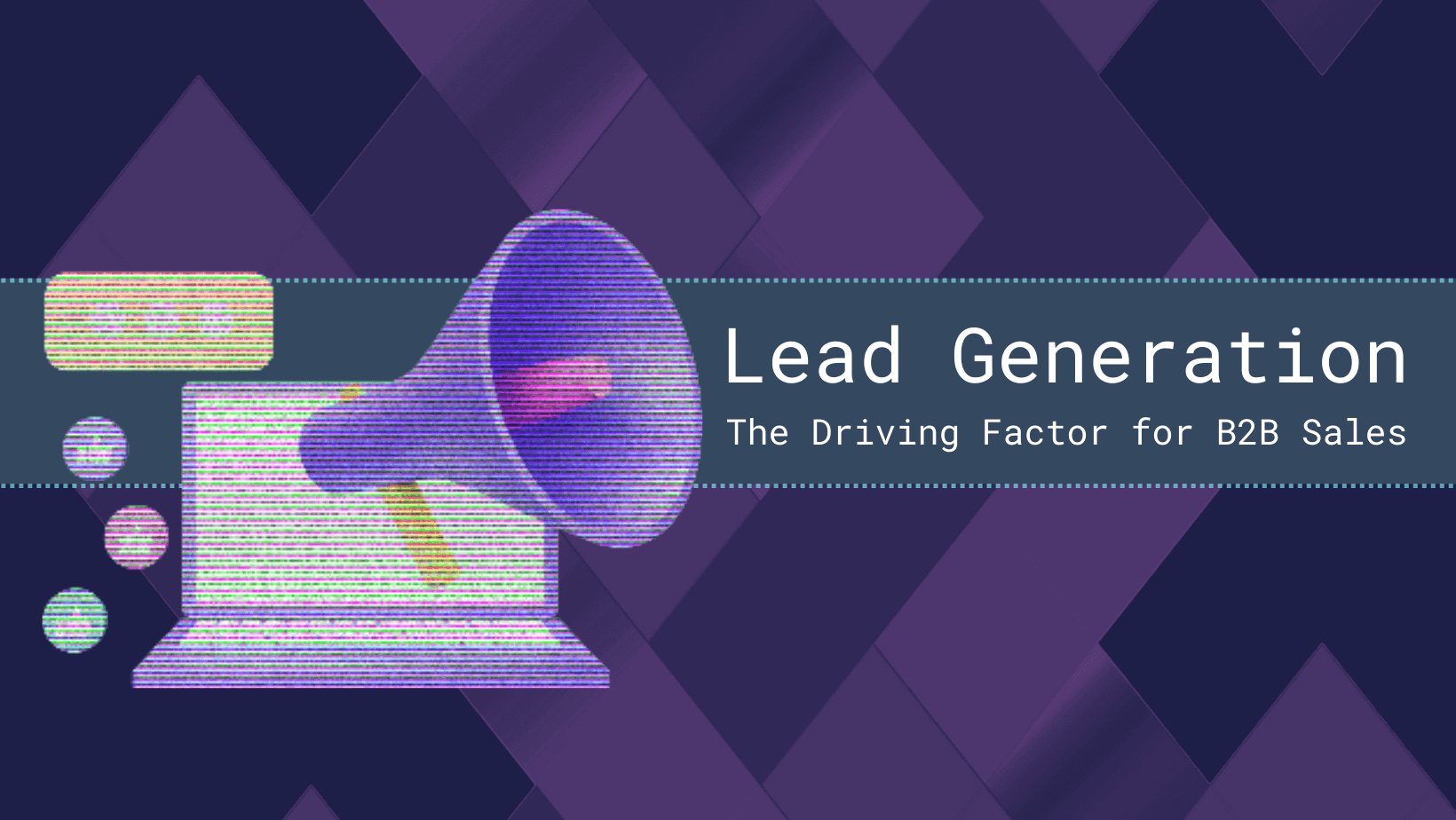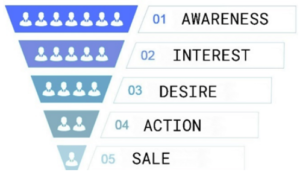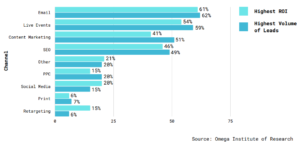- Industries
Industries
- Functions
Functions
- Insights
Insights
- Careers
Careers
- About Us
- Marketing & Advertising
- By Omega Team

There is an old adage in business – If your company is not growing, it is dying. This might sound harsh, but the premise is pertinent, particularly today with all of the challenges and obstacles facing businesses with regard to competition in the digital age as well as increasing costs and the gaining importance to not only remain relevant but in the constant need to differentiate in order to attract and retain customers.
Of course, customers already in a business’ pipeline can be cultivated for growth but without a steady influx of new customers it can be only a matter of time before a company can find its pipeline drained.
Enter the notion of Lead Generation, the proactive practice of attracting new customers to a business. A Lead is simply a potential customer that indicates interest in a business’ products or services. But this alone is only the beginning task of the concept in total, which implements ideas wherein customers are not only attracted, but qualified, nurtured and engaged in an effort to initiate and build relationships and ultimately earn their recurring revenue. Important to the concept are strategies toward which a company’s revenue Funnel is kept full.
The Idea
Figure 1: Lead Generation Revenue Funnel

A business’ Lead Generation Revenue Funnel reflects the focus to recruit customers and manage them through five successive stages of development from awareness to the crucial sale. Keeping this Funnel full ensures that a company is able to sustain maintenance in the cases of customer attrition, or support growth efforts while safeguarding against revenue declines.
The five stages of the Lead Generation Revenue Funnel are:
1. Awareness: Recognition of the business and its products or services.
2. Interest: A Lead raises interest in the business’ products or services and is educated.
3. Desire: A Lead forms desire for the business’ products or services and that desire is nurtured.
4. Action: A Lead decides to purchase the business’ products or services and is cultivated toward sale.
5. A Sale is generated and the Lead becomes a customer.
As one would expect, not everyone that becomes aware of a business’ products or services will be interested in them and not everyone that is interested in the products or services will form a desire for them, and so on. At each stage, the business is best served by implementing strategies to effectively manage each Lead through the Funnel to the next stage in succession, recognizing that the effectiveness of this endeavor directly affects the likelihood that Leads will become customers and incremental revenue is generated.
Lead Nurturing and Types of Leads
The process of cultivating Leads through each stage of the Funnel while developing and reinforcing relationships is called Lead Nurturing. Attention to who each Lead is, as well as where they are in the Funnel process dictates the kind of engagement required to effectively coach them through the Funnel toward a purchase decision by timely providing to them the most appropriate and relevant content and information for their situation.
Additionally, by following effective Lead Nurturing practices with every Lead in an active way with these considerations in mind, businesses can be assured that no Lead is left behind and revenue opportunities are always maximized. As Leads advance through the Funnel with a business’ active coaching and collaboration, determining and tailoring the most relevant communication and content to be offered can be supported as Leads progressively segment into four types:
- Marketing Qualified Lead (MQL): A contact that has been engaged through the business or website, or one with a positive response to marketing with an expressed interest, but not ready to receive a sales call.
- Sales Qualified Lead (SQL): A contact that has actively demonstrated an interest in the business’ products or services as well as a higher level of interest in potentially making a purchase.
- Product Qualified Lead (PQL): A contact who has participated in a product or service demonstration and has demonstrated an intent to purchase.
- Service Qualified Leads: A contact that has expressed a decision to the sales team or customer service that they desire to make a purchase and become a customer or an existing customer who has expressed a wish to upgrade to a higher level of service.
B2B and B2C Considerations
Every business needs to know and understand their target audience and who it is that will be making purchase decisions. These target audiences can differ greatly, not only from business to business but much more so when comparing B2B entities against B2C entities. Among many variances, companies that sell to businesses must direct efforts toward a relative few stakeholders compared to those that sell to consumers, which might include any individual with buying power. The comparative value and longevity of successfully guiding Leads through the Lead Generation Funnel will also differ between the two.
Although the conceptual sequence of events through the Funnel and Lead progression remains the same, the messaging and methods to generate and manage Leads require different approaches, out of necessity. As such, it follows that it is rarely the case that where a B2B business finds success a B2C will in the same way.
Strategies and Approaches
The roles of digital marketing and big data in today’s business environment cannot be understated. Not only can we share information and influence decision makers around the globe in a matter of seconds but acquiring intelligence toward prospective business opportunities can be attained as quickly with a few clicks or keystrokes.
The old days of scanning classified ads in the local newspaper and relying on snail mail for contact correspondence are gone forever, necessarily yielding to Lead Generation strategies and approaches as practiced today in the digital world.
Outbound and Inbound Marketing
Marketing plays an integral role in keeping the Lead Generation Funnel full and there are a number of ways in which businesses can connect with potential customers.
The outbound marketing approach is one of proactive outreach, casting a wide net in an attempt to capture Leads by soliciting responses from a large group that, although highly targeted, may or may not be interested in the business’ message. Traditional advertising methods can be thought of as outbound, including campaigns centered around vehicles such as direct mail, print and broadcast, email list blasts, website banners and cold-calling, among others. Although measurably successful, today’s primary issue with outbound marketing may be that with so much noise vying for attention, these unsolicited outbound efforts can often be disregarded, ignored or cast aside. Nevertheless, it is an approach preferred by many businesses that have realized worthwhile ROI.
The inbound marketing approach is one that seeks to attract and engage Leads organically with content and resources optimized to find their way in front of prospective customers actively searching for information to fill a need. This approach is typically more meaningful for those that encounter such content, as the requisites that elicited these encounters are typically initiated by the prospective customers themselves.
The building blocks of an effective inbound marketing approach include having a compelling website with clear messaging and keyword-rich content optimized for search engines (SEO), content promotion on social media, and pay-per-click advertising (PPC). Significantly, links to the business website should contain a strong calls-to-action (CTAs) worthwhile for contacts to submit information and qualify them as Leads.
Although inbound marketing practices are understood to be superior in terms of capturing and grooming qualified Leads, most businesses today employ a combination of both approaches toward their well-rounded overall marketing efforts.
Channel Effectiveness
Ask five different businesses what the best Lead Generation approach is and you may likely get five different answers. Along with B2B and B2C diversities, every business has different audience skillsets and biases and every segment of target customer may most effectively be captured in different ways.
For example, in one study by a customer management software company of B2B businesses, SEO was concluded to be the best Lead Generation approach when asked, “What percentage of your company’s leads come from the following sources?”.
Figure 2: B2B Business Study Results

Figure 3: Alternate Study Results Asking the question “what percentage of your company’s leads come from the following sources?”

The notable lesson is that every business needs to determine for itself which channels provide the best ROI for their target audiences for the purposes being pursued. It is commonly held that for maximum marketing effectiveness, both outbound and inbound marketing practices should be implemented in combination, but testing and experimentation are a valuable exercise in order to ascertain where and to what extent their well-rounded efforts should be balanced. Further, it is important to recognize that how a Lead Generation channel is used is more important than the channel chosen for use.
Nonetheless, approaches most consistently at the top of business’ lists are email marketing, search marketing, social marketing, content marketing and conversion rate optimization.
Paid Leads and Services
Outside of utilizing outbound and inbound marketing practices, a business may also choose to pay a third party to generate Leads for them. Services from these companies range from providing lists of contacts for them to pursue to full-service administration of Lead Generation and Customer Relationship Management (CRM). For businesses that are short on staff or simply prefer to outsource or supplement existing Lead Generation initiatives, these may be viable options.
Quality over Quantity
The quality of a Lead is commonly in direct correlation with the worth and method in which it was obtained. Outbound efforts need to be highly targeted to a well-understood audience and present strong, distinct and influential messaging.
Inbound strategies are reinforced as compelling and non-deceptive CTA propositions remain useful and relevant and backed by website landing pages with clear messaging, credible branding and problem-solving offerings. When a business prioritizes the number of Leads generated while sacrificing quality, much time and energy is often wasted in the pursuit of managing unqualified Leads in an effort to make a sale.
Lead lists gained from third-party companies can vary in quality as much as target audiences do. When acquiring lists, it is important to understand the mentalities and capabilities of the company from which they are purchased and how well they can match up results with the business’ industry and pertinent target demographics. Finding the right match can translate into significant ROI for the business, often with the same or less effort than without.
Lead Generation should not simply be a numbers game, but one of consistently improving quality and efficiency.
A Bigger Picture
The most successful businesses while employing Lead Generation initiatives also prioritize brand building to keep their Lead Generation Funnel full. Equally important and hand-in-hand with Lead attraction are initiatives purposed to strengthen trust, confidence and authority as Leads are attracted and progress to purchase.
Lead Generation vs. Demand Generation
As Lead Generation initially strives to increase awareness of a business’ products or services and nurture contacts in progression through the Lead Generation Funnel, Demand Generation not only contributes to this endeavor but as essentially, encourages contacts to remain in the Funnel and progress to purchase. They are two different but related processes included in an effective overall marketing strategy and combined together, result in much healthier returns throughout the Lead Generation process.
The purpose of Demand Generation is to boost brand awareness, establish and retain trust and authority, provide education, and organically create and fortify demand for a business’ partnership. Primarily digitally delivered and SEO driven, offered resources for Demand Generation are informative, educational, thought-provoking and often entertaining, while always non-gated (or free to access and share).
Effectively deployed, these activities increase the Lead Generation success rate as more Leads not only enter and reach the bottom of the Funnel, but the longevity of customers that attain such status, further often turn into advocates of the business. Ways that Demand Generation can be included into overall marketing initiatives to create more confident prospects include social media posts, webinars and live events, press releases, branded videos, blogs, guest posts and trend articles.
Top Line and Bottom Line
Clearly, the effective utilization of sound Lead Generation practices can make a significant difference in the success and growth of a business. Of course, these efforts incur a cost, whether it be time and resources or simply the wherewithal to put them into place and execute them. But it is similarly clear that without such efforts to keep the Funnel full and maximize the success of each Lead reaching purchase, the ratio of cost versus likely incremental revenue and profit when executed mindfully and meaningfully almost always present favorable scenarios.
A business is not fully in control of its future if it does not manage opportunities. Particularly in today’s environment, that is indeed a risky proposition.
Summary and Conclusion
Lead generation is the idea and process of attracting, managing, coaching and strengthening relationships with contacts to develop interest, trust, authority and demand to gain customers and drive sales. Leads are contacts with interest who are nurtured through the Lead Generation Revenue Funnel in successive steps from awareness to eventual purchases. Every business has variances with regard to target audience, most notably amongst those that cater to other businesses against those that sell to consumers, and strategies and approaches to attract and manage these audiences vary accordingly.
These strategies employ marketing initiatives including outbound and inbound approaches, which are commonly used in balanced combination, each with varying costs and returns. The Lead Generation concept works best in coordinated combination with Demand Generation, which supports all stages within the Lead Generation Revenue Funnel and maximizes ROI for businesses that prove efficiency at implementing the concept in whole.
Many challenges exist for businesses today that warrant the efficient utilization of Lead Generation principles, which are a clear benefit to business maintenance and growth when executed meaningfully. Even in circumstances where resources are low, arrangements can be made with relatively low cost with third-party companies offering any level of assistance.
Subscribe
Select topics and stay current with our latest insights
- Functions